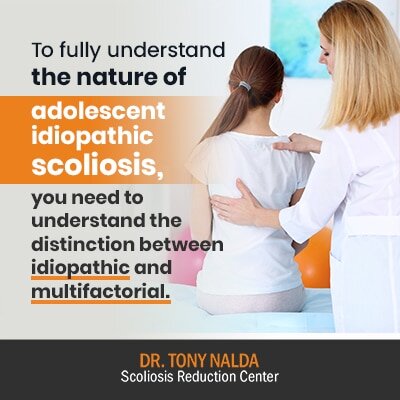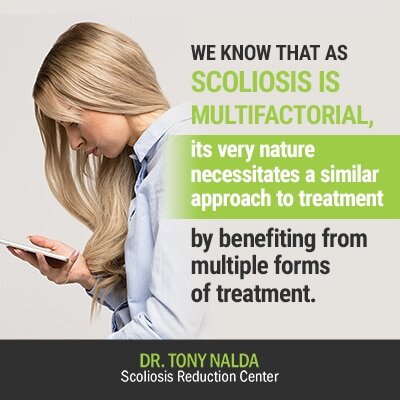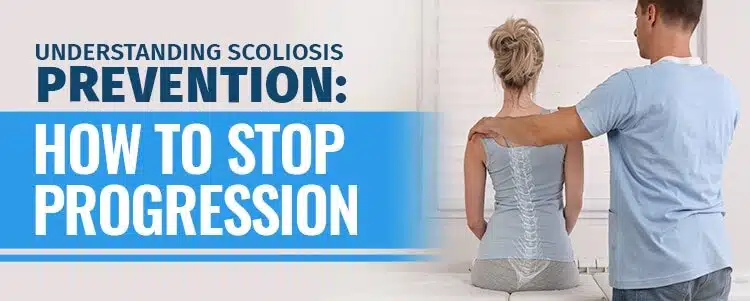It’s a natural and positive thing for people to wonder what they can do to prevent the development of certain conditions. It means they are thinking ahead, being proactive with their health, and honoring that old adage of an ounce of prevention being worth a pound of cure; this is certainly the case in preventable conditions, but unfortunately, scoliosis is not one of these. While there are some forms of the condition with known causes, the vast majority of scoliosis cases are classed as ‘idiopathic’, meaning no known single cause. When we don’t fully understand what causes something, we often lack the ability to stave off its development.
In order to better understand the misnomer that is ‘scoliosis prevention’, let’s first take a look at some of the condition’s complex characteristics. For our purposes here, we are going to focus on the condition’s most common form: adolescent idiopathic scoliosis (AIS).
4 Key Takeaways
- Understanding Scoliosis: Scoliosis, particularly Adolescent Idiopathic Scoliosis (AIS), is a complex and common spinal condition, affecting millions worldwide. With idiopathic cases lacking a known single cause, it remains a condition with multifactorial influences, making prevention challenging.
- Familial vs. Genetic Factors: While scoliosis is described as ‘familial’ and not strictly genetic, this distinction emphasizes the complexity of its causation, involving a blend of shared family traits beyond genetics, such as environment and lifestyle factors.
- Progressive Nature of Scoliosis: Scoliosis is inherently progressive, with growth and development being primary factors influencing its progression. This underscores the importance of monitoring and potentially intervening early, especially during adolescence.
- Conservative Treatment Efficacy: Although scoliosis can’t be prevented or cured, modern conservative treatments at the Scoliosis Reduction Center® offer effective management options. These treatments focus on structural correction, progression management, and maintaining spinal function without resorting to invasive surgeries.
How Common is Scoliosis?
While most people have heard of scoliosis, I bet they would be surprised at just how common it is.
To throw some stats out there, current estimates by the National Scoliosis Foundation put close to seven million people living with scoliosis in the United States alone. Clearly, if we were to add to that the amount of people diagnosed with the condition world-wide, that number would grow exponentially.
Also, given the nature of the condition and how difficult it can be to diagnose, we can only guess at how many people are living with the condition unaware around the globe.
Amongst school-aged children, scoliosis is the most common spinal deformity, and scoliosis accounts for 20 percent of total spinal-deformity cases in the States.
The Most Common Form of Scoliosis
Part of the reason scoliosis is so often described as a complex condition is because of its many forms.
Scoliosis can develop at any age and stage of life. While there are some known causes such as neuromuscular conditions like cerebral palsy and muscular dystrophy, a congenital defect such as a malformed vertebra in the spine, trauma or degenerative causes, the bulk of cases don’t have a known cause.
The above types of scoliosis with known causes only make up 20 percent of diagnosed cases; the remaining 80 percent fall into the category of adolescent idiopathic scoliosis as they are diagnosed between the ages of 10 and 18 and have no known single cause.
Idiopathic

To fully understand the nature of adolescent idiopathic scoliosis, you need to understand the distinction between idiopathic and multifactorial. While idiopathic means no known ‘single’ cause, it doesn’t necessarily mean there aren’t multiple causes.
This has become the general consensus with AIS: that it can be caused by a number of factors, that we don’t fully understand, and that can vary from person to person.
A common factor we have isolated is growth and development, which explains why the condition mainly develops during adolescence. While we believe this has a lot to do with tension on the spinal cord during growth and understand this as the main cause of progression, it’s not exact, and it’s not something we can prevent.
There are, I believe, around 70 theories on scoliosis causation in adolescents, and while many have correlations that are found, no specific cause has been isolated. This brings us to another main question people have about scoliosis: is it genetic?
This is a hard one to explain because while we describe the condition as ‘familial’, that’s not the same as saying it’s genetic.
Genetic vs. Familial
A lot of times, when a condition is classed as genetic, there is only so much a person can do to prevent its development. There can be diet and lifestyle choices that can lessen their chances of developing it, but for highly genetic conditions and diseases, this means there is a genetic mutation or specific gene responsible for its causation.
There are genetic diseases and conditions where people choose to get tested to find out if they carry the specific gene known to cause the condition, while others opt for not knowing.
To say a condition is not preventable doesn’t necessarily mean it’s genetic. When it comes to scoliosis, we describe it as ‘familial’, rather than ‘genetic’. This is because despite the studies that have been done and attempts made over the years to isolate a specific gene responsible for its development, these have been unsuccessful.
However, we have noticed that scoliosis can tend to run in families. One thing people often overlook is that families share a lot more than just their genes. They share common socioeconomic factors, diet, lifestyle, posture, stress-management skills, and their environment.
There have also been twin studies done where one twin develops scoliosis, while the other doesn’t, or one develops a completely different type of curvature from the other. If scoliosis was 100-percent genetic, twins would both develop scoliosis with the same characteristics, but this isn’t always the case.
So this is another aspect of scoliosis that makes it impossible to prevent. The number of shared factors within a family that might be correlated with the ‘why’ and ‘how’ of the condition’s development are still multifactorial and difficult to pinpoint.
If we could isolate a specific cause, we might be a step closer to figuring out if that cause could be manipulated enough to where we could prevent the condition from developing in the first place, but we’re still not there.
That being said, what I say to my patients is that not fully understanding the cause doesn’t mean we don’t fully understand its treatment. This is where we excel: managing the condition’s progression so our patients can continue living their best lives throughout treatment and beyond.
Scoliosis is Progressive
In addition to AIS being unpreventable and idiopathic, it is also classed as ‘progressive’. What this means is that it’s in the condition’s nature to worsen over time.
While no one can tell exactly how fast or slowly a person’s condition will progress, there are certain markers we look for that indicate likely rates of progression: mainly growth and age.
Growth
One factor that we know plays a huge role in a person’s experience of scoliosis is related to growth. The more growing a patient has yet to do, the more we know progression is going to be a factor.
This is why scoliosis most commonly develops within the age group moving into a significant stage of rapid growth and development: puberty.
When we diagnose an adolescent with scoliosis, we know a huge part of our treatment approach is going to be monitoring them for progression. We will be ordering X-rays that accompany growth to assess how that growth is impacting their curvature.
If a patient grows an inch, I’ll want a new X-ray done so we know exactly how the spine is responding to that growth; if their curvature is progressing as they grow, I’ll have to tweak aspects of their treatment accordingly to help stay ahead of the curve.
Age
With growth in mind, you can see why age is another big factor in scoliosis. If an adult comes in to see us, they tend to have one of two main types of scoliosis: a continuation of AIS that just wasn’t diagnosed, or what’s referred to as ‘adult do novo’ scoliosis.
The former is by far the most common form. While it seems hard to imagine someone moving through adolescence and into adulthood without noticing a spinal deformity, scoliosis can be very hard for anyone other than an expert to spot.
When scoliosis first develops, part of the diagnosis process is to class the condition as either mild, moderate, or severe: there is a big range of condition severity and related symptoms.
The designation is based on a measurement called the ‘Cobb angle’. This is taken from an X-ray and involves measuring the most-tilted vertebrae of the curvature to determine how far from a straight alignment the scoliosis spine deviates.
The higher the Cobb angle, the more severe the condition is. Often, when the condition is first diagnosed, it’s in its mildest stage. It’s not until the condition progresses in severity that it starts to produce many noticeable symptoms, such as changes to posture and gait. In some cases, these noticeable symptoms, along with pain, don’t become apparent until adulthood.
At this point, it’s most often pain that brings adults in to see me. Once growth is no longer a factor, the spine becomes vulnerable to the compressive forces of the curvature, and this can cause pain in the back and radiating pain into the legs, arms, and feet.
Adults who have developed scoliosis fresh in adulthood are known as ‘de novo’. Most often, this is the result of degenerative changes to the spine or is trauma-induced. In these instances, the cause of the scoliosis has to be addressed before any treatment can produce a structural change.
As the number-one trigger for progression is eliminated in adults (growth), we know that their scoliosis is likely to progress at a slower rate, and we tailor our treatment approach accordingly.
Scoliosis Reduction Center® Treatment Approach
Although we can’t prevent scoliosis from developing initially or permanently reverse its effects once it does, we can effectively manage the condition’s progression and give our patients the skills and knowledge to sustain those results.
Here at the Scoliosis Reduction Center®, we follow a conservative treatment approach. What that means is that we strive to treat our patients through natural and noninvasive means that help them avoid the need for surgery down the road.
Traditional Treatment
Those who choose to follow the traditional treatment path are often funneled towards spinal-fusion surgery, and this is what we want to avoid.
Spinal fusion is costly, invasive, carries heavy side effects, and there’s not enough long-term data to indicate what life 40, 50, or 60 years post surgery will look like.
Not only are there the average risks of surgery, there is also the price of living with rods and screws attached to your spine. This comes at the cost of flexibility and mobility. A spine that’s held in a fixed position isn’t the same as one that’s naturally moved into a corrective position through strength and support.
Once there are rods holding a spine in a straighter alignment, the spine’s ability to absorb force is lessened, as well as its ability to maintain a certain level of flexibility.
Another factor that is often overlooked are the psychological ramifications of such a surgery. Patients often report how living with the fear of having a rod break or a screw come loose, which is a real risk, affects their confidence in trying new things or even enjoying the activities they did pre-surgery.
The problem is once you have spinal fusion, there’s no going back. If the surgery doesn’t yield positive results the first time around, the only additional treatment option is subsequent surgeries.
While there is a patient follow-up two, and sometimes five, years later, studies of long-term effects don’t extend past that, so we really don’t know what life will be like for a person who’s had spinal fusion in the long term.
It does also make sense that all hardware has a lifespan, so at some point, it’s likely that the rods or screws will malfunction, degenerate, or break. At which point, another surgery will be necessary.
Conservative Treatment

As mentioned, here at the Center, we believe there are better treatment options available. We believe that a conservative approach that customizes each and every patient’s treatment plan to address the individual characteristics of their condition can yield impressive results with minimal side effects.
We know that as scoliosis is multifactorial, its very nature necessitates a similar approach to treatment by benefiting from multiple forms of treatment. Here at the Center, our patients have access to different forms of treatment under one roof, which is a rare occurrence and carries some intense benefits.
This accessibility is the keystone of our approach. We can design a comprehensive treatment plan that draws from multiple treatment disciplines: therapy, rehabilitation, corrective bracing, and chiropractic.
As we have the certifications and experience in multiple modalities, we have the ability to tweak treatment and apportion these disciplines accordingly for a fully-customized approach.
Our goal is to first address the structural issue of the curvature by manipulating the spine to move into a straighter alignment. Once we have achieved that, we want to focus on maintaining the spine’s corrective position, strength, flexibility, and stabilizing it.
Every discipline we use from corrective bracing to exercise and chiropractic is scoliosis-specific, and this is why we have the power and ability to make a big impact structurally, while avoiding the dangers associated with spinal-fusion surgery.
Conclusion
So can we prevent scoliosis from developing: no. What we can do, however, is actively treat it with an approach that addresses the structural component of the curvature and manages the condition’s progression.
Can we cure scoliosis: no. Even with successful treatment, a person who has scoliosis will likely never have a perfectly-aligned spine again. However, with some engagement and hard work, a curvature reduction can be achieved in such a way that the spine can maintain its flexibility, strength, and stabilize itself.
Here at the Scoliosis Reduction Center®, we work with our patients along their path from diagnosis to treatment and life afterwards. We empower them with the knowledge and ability to sustain treatment results through scoliosis-specific chiropractic care, exercise, diet, and lifestyle guidance.
Even though scoliosis can’t be prevented or cured, it doesn’t have to equate a life of limitation. Fortunately, over the years, the medical field has widened its approach to treating scoliosis to include a conservative path proven to yield impressive results and give patients a favorable alternative to invasive surgery.





